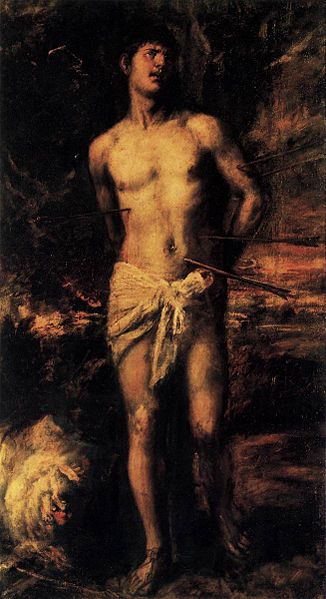Tiziano. Who/What/Where
0
CHI/WHO: Tiziano
COSA/WHAT: La Pietà - 1576
DOVE/WHERE: Gallerie dell'Accaddemia, Venezia
Tiziano Vecellio,known as Tiziano (1473-1490c.a. – 1576), was born in Pieve di Cadore,
near Belluno in the Republic of Venice.
He is the most important member of the 16th-century Venetian school.
The painting is titled La Pieta monster. It is, according to tradition, the last work of Titian, because it was found in the study of the master unfinished at his death on 27 agorsto of 1576 due to an epidemic of plague. The work was finished by Palma the Younger as the inscription on the lower canvas: "QUOD Titianus INCHOATUM RELIQUIT / PALM REVENTER ABSOLVIT / DEOQ. DICAVIT OPUS ".
The Pieta was built by Titian for his own tomb in the Church of the Frari, and is an ex-voto, imploring an end of the plague. In the lower right is a votive tablet, with Titian and his son Orazio intent to seek divine intercession to be saved by the epidemic, theme taken from the arm that appears at the foot of the Sibyl, pleading, which expresses the anguish of the artist for the disease. All this will not be enough, and both father and son will be killed by the epidemic.
This work, in addition to being the last work of Titian, is part of the group of paintings that you have a more intense and extreme, where instead of a brush the color is faded and stretched out with your fingers. These are works that seem to be ahead of times and have a style that is in some ways closer to what you will see in the following
centuries with the Impressionists and reminiscent of the style "unfinished" by Michelangelo.
Tiziano Vecellio, conosciuto semplicemente come Tiziano (1473-1490c.a.
– 1576), nacque a Pieve di Cadore,
vicino a Belluno e facente parte della repubblica di Venezia. Egli
è il pittore più importante della scuola veneziana del 16° secolo.
Il dipinto che qui vi presento è intitolato La Pietà. Si tratta, secondo la tradizione, dell’ultimo lavoro del Tiziano,
poichè fu trovato incompiuto nello studio del maestro alla sua morte il 27
agorsto del 1576 a causa dell’epidemia di peste che infuriava a Venezia quell’anno.
L’opera venne ultimata da Palma il Giovane come attesta l’iscrizione posta in
basso sulla tela: “QUOD TITIANUS INCHOATUM RELIQUIT/ PALMA REVENTER ABSOLVIT/
DEOQ. DICAVIT OPUS”.
La Pietà venne realizzata dal Tiziano per la propria sepoltura
nella Chiesa dei Frari ed è un ex voto, per implorare la fine della peste. In
basso a destra appare una tavoletta votiva, con Tiziano ed il figlio Orazio
intenti a chiedere l'intercessione divina per essere salvati dall'epidemia,
tema ripreso dal braccio che compare ai piedi della Sibilla, implorante, che
esprime l'angoscia dell'artista per la malattia. Tutto ciò non basterà ed
entrambi, padre e figlio, saranno uccisi dall'epidemia.
Quest’opera, oltre ad essere l’ultimo lavoro del Tiziano, fa parte
del gruppo di dipinti che si hanno uno stile più intenso ed estremo, dove al
posto del pennello il colore è steso e sfumato direttamente con le dita. Si
tratta di opere che sembrano precorrere i tempi e hanno uno stile che per certi
versi si avvicina a ciò che si vedrà nei secoli successivi con gli
impressionisti e che ricordano lo stile “non finito” di Michelangelo.
 |
|
Tarquinio
e Lucrezia
dell’Akademie der Bildenden Künste di Vienna |
 |
|
Incoronazione
di spine
dell’Alte Pinakothek di Monaco |
 |
|
San
Sebastiano
dell’Ermitage di San Pietroburgo |
 |
|
Ecce
Homo
nelle versioni del Prado |













.jpg)








